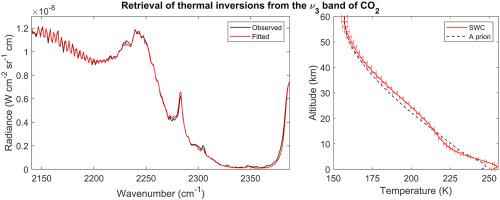Planetary and Space Science ( IF 1.8 ) Pub Date : 2021-02-16 , DOI: 10.1016/j.pss.2021.105186 Sophie Bauduin , Marco Giuranna , Paulina Wolkenberg , Luca Nardi , Frank Daerden , Jimmy Bouche , Catherine Wespes , Gilles Lecomte , Ann Carine Vandaele , Pierre Coheur

|
Nadir remote sensing of the night side of Mars is challenging, mainly due to the low signal-to-noise ratio of such observations. We show in a companion paper that the abundance of carbon monoxide (CO) during night can be retrieved from the observations of the Planetary Fourier Spectrometer (PFS). This requires, however, an accurate knowledge of the temperature profile, and especially of the night-time thermal inversions, to properly model the atmospheric emission. While the temperature profile is usually retrieved from the ν2 band of CO2 (centered at 667 cm−1), this work shows that, for averaged night-time PFS observations built from a large ensemble of spectra, the temperature profile can be retrieved from the more saturated ν3 band of CO2 (centered at 2349 cm−1). We show especially that, due to IFOV (instantaneous field-of-view) size differences and boresight offset between the longwave and shortwave channels of PFS, the temperature profile retrieved from the ν3 band is more consistent with the emission observed in the 1-0 band of CO (centered at 2143 cm−1), which is used in the second part paper. We provide a complete characterization of the retrieved temperature profiles in terms of error and vertical sensitivity. Using this, we show that using the ν3 CO2 band allows to properly constrain and characterize the thermal inversions encountered near the surface for most night-time observations. The resulting set of temperature profiles is essential for the retrieval of the night-time CO abundance that is presented in the companion paper. Beyond their usefulness for the night-time CO retrieval, we suggest with a last example that temperature profiles retrieved from the ν3 band of CO2 could be use more generally to study surface thermal inversions encountered at night.
中文翻译:

利用PFS / MEX短波信道的夜间平均频谱。第1部分:从CO温度检索2 ν 3带
火星夜侧的天底遥感非常具有挑战性,这主要是由于此类观测的信噪比低。我们在随附的论文中显示,可以从行星傅里叶光谱仪(PFS)的观测值中检索出夜间的一氧化碳(CO)丰度。但是,这需要对温度曲线(尤其是夜间热反演)有准确的了解,才能正确地模拟大气排放。虽然温度分布通常是从检索ν 2 CO的带2(667 cm -1为中心-1),这项工作表明,对于从大合奏光谱的内置平均夜间PFS观察,温度分布可以是从更饱和的ν中检索3条带状的CO 2(以2349 cm -1为中心)。我们表明特别是,由于IFOV(瞬时字段的视图)的大小差异和视轴PFS的长波和短波信道之间的偏移量,从检索到的温度分布ν 3带是与所述1-观察到的发射更一致CO的0带(以2143厘米-1为中心),用于第二部分纸中。我们根据误差和垂直灵敏度对检索到的温度曲线进行了完整的描述。使用此,我们表明,使用ν 3 CO 2谱带可以适当地限制和表征大多数夜间观测中地表附近遇到的热反演。所得的温度曲线集对于检索随附论文中介绍的夜间CO丰度至关重要。超出其有用性的夜间CO检索,我们建议用一最后的例子,从所检索的温度分布ν 3 CO的带2可以使用更一般地在夜间遇到研究表面热反转。










































 京公网安备 11010802027423号
京公网安备 11010802027423号